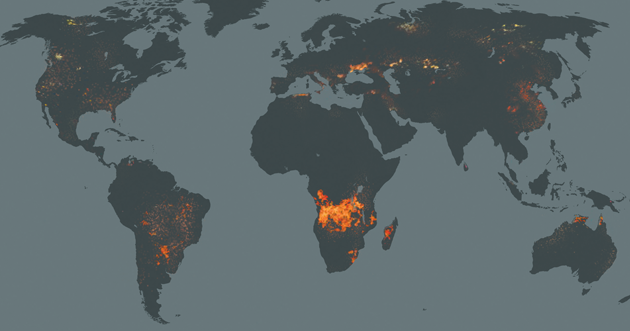If it seems as though the world’s on fire, that’s because it is. Wildfires are starting earlier in the dry season and burning for longer. As of October 2017, European Union countries had reported more than 1,600 fires, which burned more than 2 million acres. In the United States, according to the Department of the Interior, there were 71,499 wildfires in 2017, which were responsible for burning 10 million acres of land and putting 4.5 million homes at risk, 2 million in California alone. Every year more than 330,000 people die from the aftereffects of wildfires. Sub-Saharan Africa accounts for nearly half this figure.

A representation of wildfires around the world in July 2017, by Dolly Holmes
The two articles that follow examine the causes and the costs of wildfires in 2017, in central Portugal and the American West. Richard Manning’s examination of the fires that raged across Montana last summer, “Combustion Engines,” blames global warming, a century of fire mismanagement, and the building of homes in fire-prone areas. Scott Sayare, in “There Will Always Be Fires,” describes the conditions in Portugal—notably the heavy planting of eucalyptus—that led to the catastrophic blazes there. Meanwhile, President Donald Trump has cut the budget of the Regional Climate Centers, which provide data used to help control and prevent wildfires.
The fires that Sayare and Manning investigate were mega-fires, defined as blazes that burn more than 100,000 acres. In the past three decades, the number of mega-fires has been increasing exponentially: before 1995 there was an average of less than one per year; in the past decade the average has increased to ten each year.
Until Europe, the United States, and the rest of the world come up with effective strategies for managing a fire-prone landscape—such as prescribed burning, and managing wildfires to restore the healthy patchwork of forests that existed more than 150 years ago—and until we deal more efficiently with climate change, greed, and improper home construction, regrettably, there will only be more mega-fires in the future.



